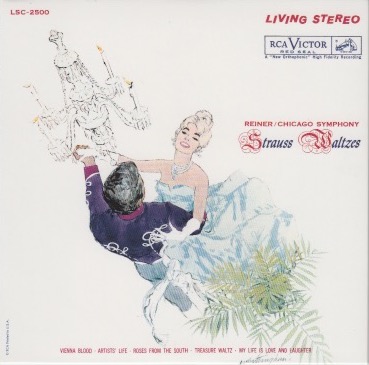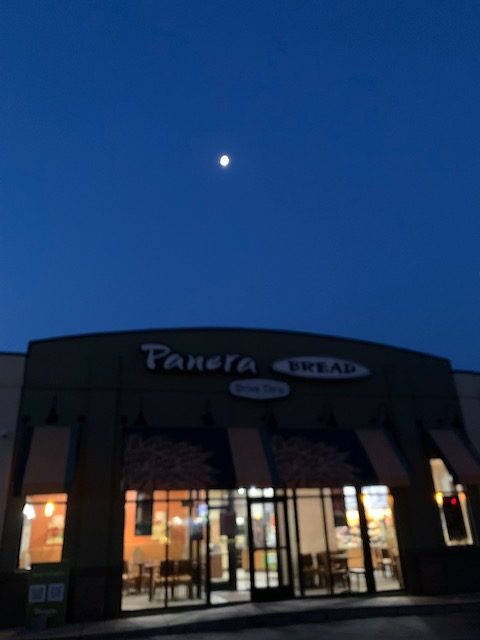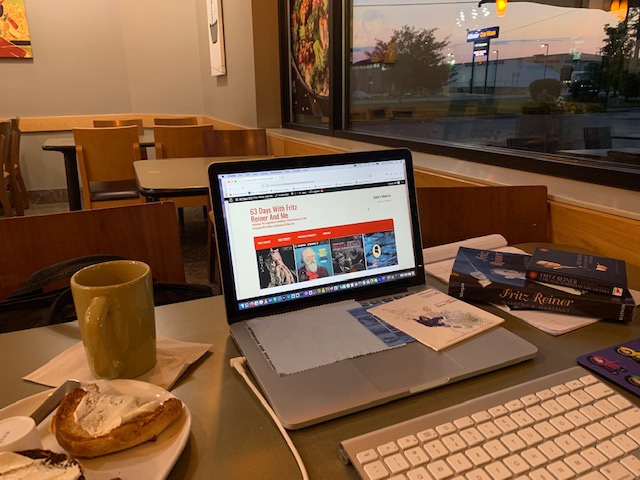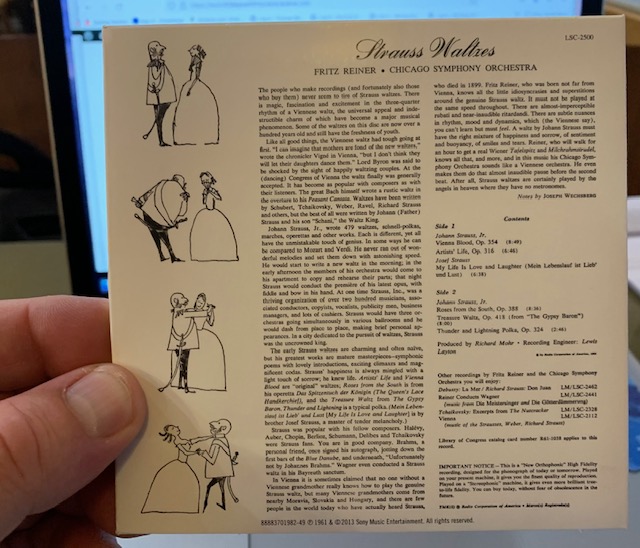
I got to my favorite Reiner-listening restaurant before it opened this morning. I didn’t mean to. I must have gotten up earlier than usual. Or farted around getting ready less than usual.
Anyway, when I saw the waning gibbous moon hung above the entrance, I did what any self-respecting prospective diner holding a satchel full of books and laptop equipment would do: I set it down and took a picture, knowing full well that my iPhone was not the Hubble telescope and that all I’d see is a blurry white dot as a result.
Sure enough. That’s what I see.
After taking the picture, I strolled up to the door and yanked. It was locked.
My car’s clock read 6:01 – time for the doors to open.

Yet, the door was locked. Hmm.
So, I looked at the clock on my iPhone and noticed that it was still only 5:58.
I made a mental note to change the clock in my car, but I’m quite sure my mental secretary will throw it away during her next straightening of notes. (Sometimes, I think she does that on purpose. But I still keep her around. Good mental secretaries are hard to find these days.)
The lights in the parking lot winked on and some kindly fellow unlocked the door and held it open for me.
I strolled in like I owned the place. Given how many years I’ve spent here, plunking down $5.91 each time, I probably do. Figuratively, at least.
As I marched my figurative ass to my usual seat (which is actually one of two places in the restaurant where I like to park my keister and haul out my laptop), set everything down, and walked back to the counter to order my usual Asiago bagel (toasted twice!) and Light Roast coffee.
I did.
And then returned to my perch, which looks an awful lot like this:

The bagel is nicely toasted today. The coffee is its usual uniquely flavored self.
As I sip and munch, I listen.
The Objective Stuff
From his entry on WIkipedia,
Johann Strauss II (born Johann Baptist Strauss; 25 October 1825 – 3 June 1899), also known as Johann Strauss Jr., the Younger, the Son (German: Sohn), was an Austrian composer of light music, particularly dance music and operettas. He composed over 500 waltzes, polkas, quadrilles, and other types of dance music, as well as several operettas and a ballet. In his lifetime, he was known as “The Waltz King”, and was largely responsible for the popularity of the waltz in Vienna during the 19th century. Some of Johann Strauss’s most famous works include “The Blue Danube”, “Kaiser-Walzer” (Emperor Waltz), “Tales from the Vienna Woods”, and the “Tritsch-Tratsch-Polka”. Among his operettas, Die Fledermaus and Der Zigeunerbaron are the best known.
Strauss was the son of Johann Strauss I and his first wife Maria Anna Streim. Two younger brothers, Josef and Eduard Strauss, also became composers of light music, although they were never as well known as their brother.
From his entry on Wikipedia,
Josef Strauss (20 August 1827 – 22 July 1870) was an Austrian composer.
He was born in Mariahilf (now Vienna), the son of Johann Strauss I and Maria Anna Streim, and brother of Johann Strauss II and Eduard Strauss. His father wanted him to choose a career in the Austrian Habsburg military. He studied music with Franz Dolleschal and learned to play the violin with Franz Anton Ries.
He received training as an engineer, and worked for the city of Vienna as an engineer and designer. He designed a horse-drawn revolving brush street-sweeping vehicle and published two textbooks on mathematical subjects. Strauss had talents as an artist, painter, poet, dramatist, singer, composer and inventor.
(“Light music,” indeed. I can’t think of music much lighter than a waltz. But I’m getting ahead of myself.)
The original album consisted of six songs split into two sides (as all vinyl albums were back in the day – save for one of which I am aware, which had three sides; but that’s for another story).
Side One:
Vienna Blood, Op. 354
Artist’s Life, Op. 316
My Life Is Love And Laughter (by Josef Strauss)
Side Two:
Roses From the South, Op. 388
Treasure Waltz, Op 418
Thunder and Lightning Polka, Op. 324
The third track on Side One is labeled “My Life Is Love And Laughter” on the album cover, although the German (according to the hardcover book in the CD box set) renders it “My Way Through Life Is Love And Pleasure!”. I’m pretty sure the word “Lust” in German is about the same as it is in English. I wonder how the album cover renders it “Laughter” rather than, at least, “Pleasure!” (With an exclamation point.)

Tracks 1, 4, and 5 were recorded on April 26, 1960. Tracks 2-4 were recorded on April 25, 1960. Maestro Reiner was in his 72nd year of life.
The Subjective Stuff:
Recording quality: 5
Overall musicianship: 5
CD booklet notes: 2
CD “album cover” information: 4 (love the cartoon drawings)
How does this make me feel: 3.5
Listening to a waltz without dancing to it is like watching a commercial for McDonald’s without being hungry. What’s the point?
These are extremely well recorded, very well performed. But why would I want to hear a waltz?
